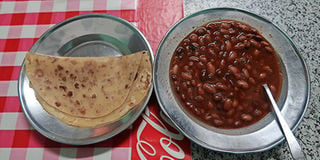Rising food prices send Nairobians to mushrooming ‘kibandaski’

A meal at a cheap and cheerful kibanda.
They say necessity is the mother of invention. It is for this reason that the runaway cost of living in Nairobi has forced most residents to discover a new source of food: makeshift eateries.
Today, at the heart of Nairobi, there is a food stall at every step, making them the go-to joints for many who are looking for a ready hot meal.
As food delivery, in particular, continues to grow and expand, food stalls have spawned a whole new business model, bringing together different people from different classes for an affordable meal, drawing customers from restaurants and fast-food outlets.
The meals sold in the vibandas appeals to customers because of its freshness and affordability, making it an easy option.
For as low as Sh100, you can get a satisfying meal.
In Nairobi, the wealthy live large, the middle class survive while the needy merely exist in the hope that the next sunrise will bring better fortunes. While living in Nairobi was already an inconvenience, the coronavirus pandemic made the situation even worse for residents.
Figures from Nairobi County show that there are over 1,500 licensed eateries in the city, 80 percent of them fast-food joints. And the number is not about to reduce.
What has given birth to these businesses? Tough economic times. Many Nairobians balance between transport money and a plate of lunch in the unforgiving tough streets of the capital.
The vibanda not only provide an affordable alternative to meals from high-end restaurants but they also provide a fresh taste, just like at home.
“I spend Sh100 on lunch here in town … and I prefer eating in a kibanda. Living in Nairobi requires you to live on a budget. For every coin that I get, I have to have budgeted on it, so if I walk into a city hotel, the best I can get with my budget is a glass of juice,” said Mr James Njoroge.
In January, overall inflation in Kenya fell slightly for the second straight month to five percent, but the prices of basic foodstuffs such as maize and wheat flour, potatoes, vegetables and fruits continued rising, which meant that restaurants had to increase their prices.
Food inflation for January stood at nine percent, meaning many Kenyans were struggling more to put food on the table.
According to the Kenya National Bureau of Statistics, the burden is much higher for poorer households, where food accounts for about 36 percent of total spending.
When Covid-19 struck in March 2020, a curfew and lockdown were imposed, something that disrupted or destroyed many livelihoods.
The economy tanked, but in April, the government announced tax relief to mitigate the effects of the pandemic. The Treasury Cabinet secretary announced that the relief would be lifted on December 30, 2020.
In February this year, angry Kenyans took to social media to complain about the high cost of living. Many shared their shopping lists, lamenting that the prices of basic food items such as milk, bread, sugar and maize flour had risen sharply, making it difficult for them to afford three meals a day.
A 2kg packet of wheat flour now goes for Sh204; a 2kg packet of maize flour for Sh145; 1kg of sugar (Sh125), a 500ml packet of milk (Sh55); one litre of cooking oil (Sh436); 1kg of rice (Sh260); 400g of bread (Sh60); and 1kg salt Sh28.
Ms Wairimu, the owner of a food stall at a bus station in Nairobi, said now and then a new food stall comes up, making it very competitive for people like her.
“Life is very hard now, so the more the food prices go up the more we increase the prices of the plate, but this business of food stalls is really growing in the CBD, making it a very competitive business,” she said.
“Not in Nairobi alone. Other cities are experiencing the growth of these vibanda. I used to sell a plate at Sh100 but now a plate of ugali, beef and kales goes for Sh150.”
She added: “Competition is very high now that Kenyans are appreciating more street food and sitting down and eating rather than going to fancy restaurants.
“Now they are coming, eating, bringing in new customers and that’s how we are surviving, but every new month you will find a new food stall.”





